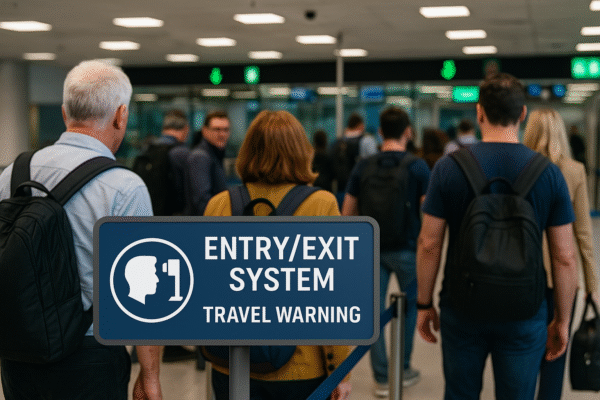Spain has joined forces with the United States, the United Kingdom, Australia, the United Arab Emirates, and Taiwan in alerting travelers about major changes coming to European borders. Beginning October 12, 2025, the European Union’s new Entry/Exit System (EES) will officially replace manual passport stamping with a digital biometric process.
This landmark transition is designed to strengthen border security across the Schengen Area. However, authorities warn that travelers should prepare for longer queues and potential delays, particularly during the initial months of implementation. Spain, as one of the most visited countries in Europe, is expected to see heavy impacts as millions of international tourists enter its borders annually.
What Is the European Entry/Exit System (EES)?
The EES is a high-tech border management system that will digitally record travelers’ entry and exit from the Schengen Area. Instead of manual passport stamping, biometric information such as fingerprints and facial scans will be collected at airports, seaports, and land borders.
Key Features of the EES
- Biometric Data Collection: All non-EU nationals will have fingerprints and facial images taken at entry and exit points.
- Digital Records: Passports will no longer be stamped; instead, a digital profile will track arrivals and departures.
- Security Benefits: Authorities can detect overstays, prevent identity fraud, and reduce illegal immigration.
The European Commission explains that the EES will improve border safety and efficiency in the long run. Still, a learning curve is expected as both travelers and border officers adapt to the new process.
Timeline of the EES Rollout
- October 12, 2025: Initial phase begins with at least one border checkpoint in each Schengen country.
- December 2025: Biometric checks expand to several additional border points.
- January 2026: Half of all Schengen border posts adopt the EES.
- March 2026: Almost full coverage with biometric processing across borders.
- April 10, 2026: Complete rollout; all travelers entering or exiting the Schengen Area will undergo biometric checks.
Spain’s New Border Requirements
Spain, which welcomes over 80 million visitors annually, has issued updated entry guidelines in line with the EES. Travelers should note the following:
- No More Passport Stamps: Manual stamping will be replaced by biometric data capture.
- Passport Validity: Passports must be issued within the last ten years and valid for at least three months after departure.
- Proof of Stay: Visitors may be required to present proof of accommodation, financial means, travel insurance, and return tickets.
- Expect Delays: Longer wait times are likely during the adjustment phase.
Spain’s Ministry of Tourism emphasizes that travelers should prepare well in advance to ensure a smooth journey.
International Warnings
Several countries outside the EU have issued advisories to their citizens about the upcoming changes:
- United States: The U.S. Department of State warns Americans to allow extra time at airports and land borders. Biometric checks will also apply at UK departure points for Schengen-bound travelers.
- United Kingdom: British travelers heading to Spain and Europe should expect longer border waits. The UK government is funding airport upgrades to help manage the transition.
- United Arab Emirates: Emirates and Air Arabia airlines are advising passengers to arrive earlier for flights to Spain and other Schengen destinations.
- Australia: The Department of Foreign Affairs advises Australians to prepare for biometric checks beginning in October 2025.
- Taiwan: Taiwanese authorities highlight the global trend toward biometric security, aligning their own travel systems with Europe’s new procedures.
Impact on Tourists and Travel Industry
The introduction of biometric border control will inevitably affect tourism, especially in countries like Spain that depend heavily on international arrivals. Industry experts predict:
- Longer Queues Initially: Peak seasons may see significant congestion until travelers and officials become accustomed to the system.
- Enhanced Security: Over time, biometric checks will help reduce risks of overstays and illegal migration, making travel safer.
- Digital Efficiency: Once streamlined, the process is expected to reduce errors and accelerate border control.
Travel agencies, airlines, and hospitality providers are already working on awareness campaigns to ensure tourists are prepared for the change.
Preparing for Your Trip to Spain
To minimize disruption, travelers heading to Spain or other Schengen countries after October 2025 should:
- Check Passport Validity: Ensure your passport meets the new criteria.
- Arrive Early: Allow additional time at airports, ports, and border crossings.
- Keep Documents Handy: Be ready to show proof of accommodation, insurance, and return travel plans.
- Stay Informed: Monitor official travel advisories from your home country and Spain.
A Transformative Step in European Travel
The European Entry/Exit System marks a significant turning point in travel history. While the transition may bring temporary inconvenience, its long-term benefits promise stronger border control, safer tourism, and more accurate immigration data.
Spain, one of Europe’s most visited destinations, is at the center of this transformation. With advisories already in place from the US, UK, Australia, UAE, and Taiwan, international travelers are urged to prepare early and travel smart.
By October 2025, visitors should expect a different border experience—digital, biometric, and future-focused—ensuring that the Schengen Area continues to balance security, efficiency, and tourism growth.
For more travel news like this, keep reading Global Travel Wire
















